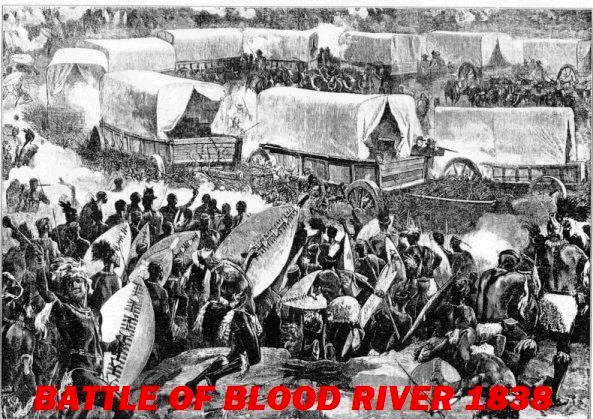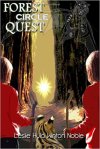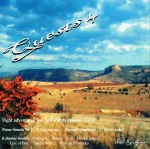In South Africa the 16th December has long been kept as a public holiday. This arose originally from a little disagreement in 1838 between some Voortrekkers trying to find a promised land away from the pesky British, and some Zulus who decided they didn’t want the Voortrekkers there, which became known as the Battle of Blood River.
 Leading up to this had been the bumping off on 6th February that year of a certain Piet Retief and his party, the official version of which became that after signing a treaty the bloke who did Chaka in, Dingaan, had called them in for a party, got them to leave arms behind, and then had them grabbed and terminated together with the agreement. Other accounts are that they were grabbed after surrounding the home Kraal in a threatening manner with intent to do witchcraft.
Leading up to this had been the bumping off on 6th February that year of a certain Piet Retief and his party, the official version of which became that after signing a treaty the bloke who did Chaka in, Dingaan, had called them in for a party, got them to leave arms behind, and then had them grabbed and terminated together with the agreement. Other accounts are that they were grabbed after surrounding the home Kraal in a threatening manner with intent to do witchcraft.
The alleged agreement got ‘lost’ – as so many important documents do in this country – so who knows?
Anyway, although the official name was ‘Day of the Covenant’ or ‘Day of the Vow’, throughout my early years the 16th December was known as ‘Dingaan’s Day‘. This had very little logical reason, because even though he was the Zulu king at the time, the attacking forces were led by his generals Dambuza and Ndlela. Also, the winner of the match happened to be Andries Pretorius, as general of a wagon commando of 470 supported by some 200 retainers (including a few Englishmen along for the ride).
‘Indillella Day’ was a non-starter, although ‘Dam-boozer Day’ would have had some attraction. Maybe ‘Pretorius Day’ as a basis – it could have become ‘Pretty Glorious Day’? He earned it. His commando had come for the express purpose of making Dingaan into a Ding-gone, and that he did. After some cat-and-mousery Pretorius managed to tempt the Zulus into attacking his force while in laager (circle of wagons) formation in defensive ground of his choosing and well short of the actual Dingaan capital, uMgungunhlovu* instead of in closer territory which would have made the wagons more vulnerable.
According to a number of sources the total Zulu force opposing them was over 30 000, so the odds were between sixty and seventy to one against the commando. However, the latter had guns, buckshot, expert marksmen, and two cannons. This combination did manage to do more than even things up. In fact, the final casualty list is reported as having been 3 000 dead on the Zulu side as against three wounded (including friend Andries who got stabbed in the hand by an assegai) on the commando one. It is not even as if the defenders lurked constantly behind the wagons. After the first couple of hours, several sorties on horseback also sort of did some of the sorting. Some of the blame for this whitewash lies with Chaka. He replaced throwing spears with short, stabbing ones which worked well against other local tribes, but not against settlers behind wagons or on horseback.
On 6th December, Pretorius had proposed a vow that if they successfully reached the Dingaan capital they would build a church and keep an annual day of celebration. This vow was, apparently, renewed just before the Blood River battle commenced. (Accounts vary here, too.) Anyhow, the vow was translated into folk history and then into law of the Afrikaans folk. After majority rule, the ‘Vow’ was taken out of the scene and ‘Reconciliation’ substituted. This followed some understandable resentment at the thought that God had intervened on the side of the ‘Trekkers.
I must say, though, that as things turned out the outcome did not prove that any divine presence was necessarily favouring the Pretorius faction. If intervention was present, it was to the benefit of the other side, too. Dingaan was of the same bloodthirsty rule-by-fear-and-murder tradition of Chaka, and two princely contenders for the leadership, who would have been equally bad, became Blood River casualties. This left, as leader, a far more reasonable man, Mpande, whom Dingaan had tried hard to get bumped off – thwarted on some occasions, ironically enough, through the protection of the other Blood River general, Ndlela. Later, by the way, Dingaan was to have Ndlela strangled slowly for ‘treachery’ after another battle had not gone as he would have hoped.
King Mpande thus came into power with a treaty separating Natal and Zululand at the Tugela River (since amalgamated as KwaZulu Natal). He founded the present, and far more moderate, dynasty. Thus, changing the holiday to ‘Day of Reconciliation’ was particularly apt.
At any rate: with it coming now that Madiba is still so prominently in mind, it should serve to remind everyone that reconciliation was the central theme of the latter part of his life. Rainbows are fleeting. Maybe that was the problem. Can’t we instead become the Spectrum Nation – and endure as such?
* (‘Um, double gin I love you,’ as later British-type residents including my aunt used to call it)
© Colonialist December 2013 (WordPress)

















History can be a difficult thing to live with and by!
LikeLike
To complete the ablative forms, we always live in or at it – of the future – and our lives stem from it!
LikeLike
😀
LikeLike
Another learning curve for me, and an enjoyable read of learning. We do often forget that the way one lives today is usually shape because of history.. thanks for the share.. 😉
LikeLike
As you can imagine, it is one of the prominent bits of Voortrekker history.
LikeLike
Nice little post on our history…
LikeLike
It is certainly one of the most amazing pieces of it!
LikeLike
fascinating little piece of history…reading history is so challenging when the problems are still part of the present…
LikeLike
It is often amazing just how far historical events can reach into the future.
LikeLike
I need to learn more about South Africa. We have a Rotary team from our district visiting Durban and surrounds in March. I wish I could go.
LikeLike
You would find it quite an experience. We have hosted a few USA exchange students and Group Study Exchange teams during ouir time in Rotary,
LikeLike
Col, I am confused, but I enjoyed your sidebar commentary. There was a min-series done on Shaka Zulu years ago. I don’t know if it was accurate, but I loved it.
LikeLike
The movie and series glorified him, to my recollection. He was actually a black Hitler.
LikeLike
Well, damn it.
LikeLike
Sometime one forgets there is history in places one has little exposure to. Thanks for the reminder and the informative post.
LikeLike
It is easy to become rather insular. Here, we have had reasonable exposure to American and UK history and customs, but many other parts of the world are unknown.
LikeLike
Was that Pretorius any relation to the one who got away with stabbing his girlfriend last year or year before
LikeLike
Quite probably a descendant. Anyway, that case is still pending. I really wish conclusive evidence had come up one way or another. Hotblooded murder with full intent – or tragic miscalculation in a state of panic?
LikeLike